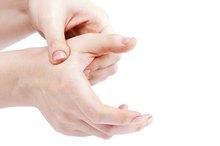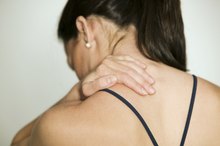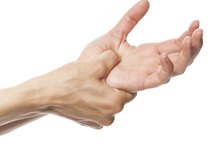Forearm & Hand Pain
The intricate neuromusculoskeletal system of the forearms, hands and wrists consists of numerous bones, ligaments, muscles, tendons and nerves. These interdependent structures provide us the ability to perform gross and detailed movements needed in daily life, sports and emergency situations. Thus, hand, wrist and forearm pain is very debilitating. "There are many common hand problems that can interfere with activities of daily living," according to The Ohio State University Medical Center 12. Hand and forearm pain may originate from a variety of sources including nerve impingement, arthritis, tendonitis, ligament injury and muscle tension.
If you are experiencing serious medical symptoms, seek emergency treatment immediately.
Nerve Impingement
Nerve signals travel in a split second from the brain to the hand. These signals originate in the brain, proceed down the spinal cord, into the spinal nerves, which branch off the spinal cord between the individual vertebrae of the neck and upper-middle back and continue through the nerves in the shoulders and upper extremities before reaching the hand. Symptoms associated with pressure on a nerve include:
- sharp shooting pain
- burning sensations
- numbness
- tingling
- weakness
- decreased mobility
- muscle atrophy
Common areas where the nerve entrapment occurs are between the individual cervical and upper thoracic vertebra, underneath the collar bone and upper chest muscles, in the elbow and inside the carpal tunnel of the wrist.
Arthritis
Causes of Elbow Pain & Tingling Fingers
Learn More
Arthritis of the hand and wrist comes in two most common forms. Osteoarthritis, also known as Degenerative Joint Disease, is a wear-and-tear disease that occurs in the joints where an injury occurred or in joints where the highest amount of stress is placed. Rheumatoid Arthritis is an autoimmune disease, in which the body's immune cells mistakenly attack the thin membrane that lines the joints 3. Both of these arthritis types may lead to pain, lack of function and disability in the hand.
- Arthritis of the hand and wrist comes in two most common forms.
- Osteoarthritis, also known as Degenerative Joint Disease, is a wear-and-tear disease that occurs in the joints where an injury occurred or in joints where the highest amount of stress is placed.
Tendinitis
Inflammation of the tissues which attach the muscles to the bone is called tendinitis. Lateral epicondylitis, also called "tennis elbow," occurs on the outside of the elbow and forearm. Medial epicondylitis, also known as "golfer's elbow" or "baseball elbow," is pain and tenderness on the pinky side of the elbow and forearm. These common sources of forearm pain occur when incorrect form, muscle imbalances or repetitive motions increase the amount of pull on the tendons attachment to the bone resulting in pain, tenderness and muscle fatigue.
- Inflammation of the tissues which attach the muscles to the bone is called tendinitis.
- Medial epicondylitis, also known as "golfer's elbow" or "baseball elbow," is pain and tenderness on the pinky side of the elbow and forearm.
Ligament Sprain and Muscle Strain
Hand Tendon Exercises
Learn More
Trauma or cumulative repetitive sub-trauma to the upper extremity can cause a sprain to the ligament or muscle strain. Trauma to the forearms, wrists, hands or thumbs can be devastating to your ability to perform simple daily activities. Sprain/strain injuries come in the form of falls, working in incorrect body positions, over-stressing a joint with repetitive motions and static positioning.
Prevention
Exercise goes a long way in hand health. An exercise routine for the entire body with emphasis on the forearms and hands increases strength, flexibility, stamina and joint range of motion. Work with correct body positioning in all endeavors and listen to your body. Pain is a signal that an underlying problem exists. Take micro-breaks from your static work positions by pinching your shoulder blades together, expanding your ribcage and taking several deep breaths.
- Exercise goes a long way in hand health.
- Take micro-breaks from your static work positions by pinching your shoulder blades together, expanding your ribcage and taking several deep breaths.
Related Articles
References
- The Ohio State Medical Center: Hand Pain and Problems
- The Ohio State Medical Center: Golfer's Elbow
- Arthritis Foundation: What Is Rheumatoid Arthritis?
- Vaquero-picado A, Barco R, Antuña SA. Lateral epicondylitis of the elbow. EFORT Open Rev. 2016;1(11):391-397. doi:10.1302/2058-5241.1.000049
- Amin NH, Kumar NS, Schickendantz MS. Medial epicondylitis: evaluation and management. J Am Acad Orthop Surg. 2015;23(6):348-55. doi:10.5435/JAAOS-D-14-00145
- Blackwell JR, Hay BA, Bolt AM, Hay SM. Olecranon bursitis: a systematic overview. Shoulder Elbow. 2014;6(3):182-90. doi:10.1177/1758573214532787
- Truong J, Ashurst JV. Septic Bursitis. Treasure Island, Fl: StatPearls Publishing; 2019.
- Varacallo M, Mair SD. Proximal Biceps Tendinitis and Tendinopathy. Treasure Island, Fl: StatPearls Publishing; 2019.
- Bellapianta JM, Lavelle WF, Lavelle ED, Onyedika I, Economedes D, Whipple R. Hand Pain. Current Therapy in Pain. 2009:156-167. doi:10.1016/b978-1-4160-4836-7.00021-3
- Moradi A, Ebrahimzadeh MH, Jupiter JB. Radial Tunnel Syndrome, Diagnostic and Treatment Dilemma. Arch Bone Jt Surg. 2015;3(3):156-62.
- Saeed W, Waseem M. Elbow Fractures Overview. Treasure Island, Fl: StatPearls Publishing; 2019.
- Athwal GS. Elbow Dislocation - OrthoInfo - AAOS. OrthoInfo: American Academy of Orthopaedic Surgeons. Oct 2017.
- Bursitis. MedlinePlus. Sept 12, 2019.
- Harvard Health Publishing. The importance of stretching. Harvard Health. Sept 2013.
- Tennis Elbow (Lateral Epicondylitis) - OrthoInfo - AAOS. OrthoInfo: American Academy of Orthopaedic Surgeons. Jul 2015.
- Shah CM, Calfee RP, Gelberman RH, Goldfarb CA. Outcomes of rigid night splinting and activity modification in the treatment of cubital tunnel syndrome. J Hand Surg Am. 2013;38(6):1125-1130.e1. doi:10.1016/j.jhsa.2013.02.039
- Biceps Tendinitis - OrthoInfo - AAOS. OrthoInfo: American Academy of Orthopaedic Surgeons. Feb 2016.
- Kinaci A, Neuhaus V, Ring D. Surgical procedures of the elbow: a nationwide cross-sectional observational study in the United States. Arch Bone Jt Surg. 2015;3(1):13-8.
- American Academy of Orthopedic Surgeons. (n.d.). Elbow Arthroscopy.
- Kane SF. Evaluation of Elbow Pain in Adults. Am Fam Physician. 2014 Apr 15;89(8):649-57.
- O'Connor FG. (2018). Evaluation of elbow pain in adults. Fields KB, ed. UpToDate. Waltham, MA: UpToDate Inc.
- Sources:American Academy of Orthopedic Surgeons (n.d.). Elbow Fractures in Children.
Resources
Writer Bio
Dr. Donald A. Ozello, D.C., is the owner and treating doctor of chiropractic at Championship Chiropractic in Las Vegas, Nevada. He is a writer for MyHealthZine.com, The Las Vegas Informer, SpineUniverse.com, "OnFitness Magazine" and various other print and online publications.









